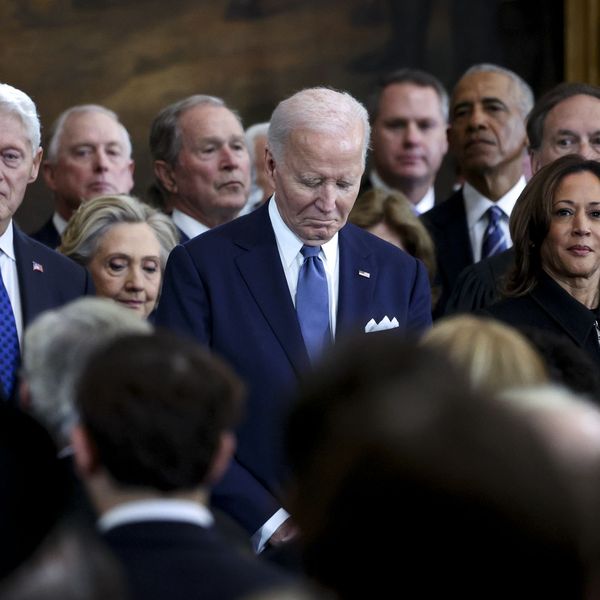
What Would Martin Luther King Jr. Think of This Biden-McCarthy Debt Ceiling Deal?
An agreement in which Pentagon spending was off the table but sharp cuts to programs that provide a lifeline to the nation's most vulnerable individuals and families epitomizes what the civil rights leader called the "madness of militarism."
The debt-ceiling deal reached by President Biden and House Speaker Kevin McCarthy that passed the U.S. House of Representatives on Wednesday is a picture of priorities that Martin Luther King Jr. deplored. While reductions in military spending are completely off the table, the knives are out for deep cuts in government programs to feed the hungry, aid children in low-income families, provide housing assistance, assist seniors and much more. This is the latest version of what King called “the madness of militarism.”
Speaking a year before his death, King described huge spending for war as a “demonic, destructive suction tube” siphoning vast resources away from anti-poverty programs to pay for warfare in Vietnam. Now, 56 years later, the nation’s military expenditures are at record highs while the Pentagon “suction tube” easily blends in with the political scenery.
The accolades were bipartisan and dissent sparse when Congress upped an annual military spending package to $858 billion last winter. The House vote was 350-80; the Senate tally was 83-11.
Today’s bloated military spending is immensely powerful, yet the end use of its power is scarcely visible to Americans.
The United States spends more money on its military than the next 10 countries combined, and most of those countries are allies. The U.S. has 750 military bases in foreign countries and territories, compared to no more than three dozen for Russia and five for China. Basic facts about these multibillion-dollar outlays don’t often see the light of day, much less receive critical scrutiny.
Meanwhile, the dominant approach of news coverage is to treat escalating Pentagon budgets as common-sense realism. Major journalistic challenges to corporate war profiteering and its consequences are few and far between. As for punditry in mainstream media, condemnation of the military-industrial complex is rare.
Today’s bloated military spending is immensely powerful, yet the end use of its power is scarcely visible to Americans. During the past decade, U.S. military actions have required fewer and fewer boots on the ground while increasingly relying on the latest technologies to appear above it all, dropping bombs and firing missiles from on high.
“We will maintain the fight against terrorism in Afghanistan and other countries,” President Biden assured Americans in late summer 2021 when the last U.S. troops left Afghanistan. “We just don’t need to fight a ground war to do it. We have what’s called over-the-horizon capabilities, which means we can strike terrorists and targets without American boots on the ground — or very few, if needed.”
When tens of thousands of ground troops were engaged in combat operations in Afghanistan and Iraq, U.S. news media provided some coverage of the impacts on them and their loved ones. American deaths and injuries were deemed newsworthy, in sharp contrast to scant coverage of the deaths and suffering of Afghans and Iraqis due to military actions subsidized by U.S. taxpayers. Now, with so much of U.S. warfare relying on air power and secrecy, media coverage of the Pentagon’s war efforts has faded almost to the vanishing point.
Although Biden claimed during a speech at the United Nations in September 2021 that “I stand here today, for the first time in 20 years with the United States not at war,” in the same month the Costs of War Project at Brown University issued a report showing that the U.S. “war on terror” was still underway on several continents. The project’s co-director, Professor Catherine Lutz, pointed out that “the war continues in over 80 countries.” And, in fact, “counterterrorism operations have become more widespread in recent years.”
With little public scrutiny, eye-popping line items for special operations are larded into yearly Pentagon appropriations before gliding through Congress and landing on the Oval Office desk for certain signature. The financing is profuse for secret military actions.
The Pentagon has reluctantly acknowledged that U.S. special operations commandos were deployed in 141 countries as this decade began. But for U.S. media, America’s engagement in some kind of warfare, whether on the ground or from the air, has been less and less likely to rise above the level of a dog-bites-human story.
Making war invisible goes hand in hand with making gigantic military budgets uncontroversial — and disconnecting the profligate spending for the Pentagon from the depletion of resources for the common good. As long as the grim impacts of massive funding for the military are concealed from the American people, the actual consequences of the “demonic, destructive suction tube” will remain hidden in plain sight.
An Urgent Message From Our Co-Founder
Dear Common Dreams reader, The U.S. is on a fast track to authoritarianism like nothing I've ever seen. Meanwhile, corporate news outlets are utterly capitulating to Trump, twisting their coverage to avoid drawing his ire while lining up to stuff cash in his pockets. That's why I believe that Common Dreams is doing the best and most consequential reporting that we've ever done. Our small but mighty team is a progressive reporting powerhouse, covering the news every day that the corporate media never will. Our mission has always been simple: To inform. To inspire. And to ignite change for the common good. Now here's the key piece that I want all our readers to understand: None of this would be possible without your financial support. That's not just some fundraising cliche. It's the absolute and literal truth. We don't accept corporate advertising and never will. We don't have a paywall because we don't think people should be blocked from critical news based on their ability to pay. Everything we do is funded by the donations of readers like you. Will you donate now to help power the nonprofit, independent reporting of Common Dreams? Thank you for being a vital member of our community. Together, we can keep independent journalism alive when it’s needed most. - Craig Brown, Co-founder |
Norman Solomon is the national director of RootsAction.org and executive director of the Institute for Public Accuracy. The paperback edition of his latest book, War Made Invisible: How America Hides the Human Toll of Its Military Machine, includes an afterword about the Gaza war.
The debt-ceiling deal reached by President Biden and House Speaker Kevin McCarthy that passed the U.S. House of Representatives on Wednesday is a picture of priorities that Martin Luther King Jr. deplored. While reductions in military spending are completely off the table, the knives are out for deep cuts in government programs to feed the hungry, aid children in low-income families, provide housing assistance, assist seniors and much more. This is the latest version of what King called “the madness of militarism.”
Speaking a year before his death, King described huge spending for war as a “demonic, destructive suction tube” siphoning vast resources away from anti-poverty programs to pay for warfare in Vietnam. Now, 56 years later, the nation’s military expenditures are at record highs while the Pentagon “suction tube” easily blends in with the political scenery.
The accolades were bipartisan and dissent sparse when Congress upped an annual military spending package to $858 billion last winter. The House vote was 350-80; the Senate tally was 83-11.
Today’s bloated military spending is immensely powerful, yet the end use of its power is scarcely visible to Americans.
The United States spends more money on its military than the next 10 countries combined, and most of those countries are allies. The U.S. has 750 military bases in foreign countries and territories, compared to no more than three dozen for Russia and five for China. Basic facts about these multibillion-dollar outlays don’t often see the light of day, much less receive critical scrutiny.
Meanwhile, the dominant approach of news coverage is to treat escalating Pentagon budgets as common-sense realism. Major journalistic challenges to corporate war profiteering and its consequences are few and far between. As for punditry in mainstream media, condemnation of the military-industrial complex is rare.
Today’s bloated military spending is immensely powerful, yet the end use of its power is scarcely visible to Americans. During the past decade, U.S. military actions have required fewer and fewer boots on the ground while increasingly relying on the latest technologies to appear above it all, dropping bombs and firing missiles from on high.
“We will maintain the fight against terrorism in Afghanistan and other countries,” President Biden assured Americans in late summer 2021 when the last U.S. troops left Afghanistan. “We just don’t need to fight a ground war to do it. We have what’s called over-the-horizon capabilities, which means we can strike terrorists and targets without American boots on the ground — or very few, if needed.”
When tens of thousands of ground troops were engaged in combat operations in Afghanistan and Iraq, U.S. news media provided some coverage of the impacts on them and their loved ones. American deaths and injuries were deemed newsworthy, in sharp contrast to scant coverage of the deaths and suffering of Afghans and Iraqis due to military actions subsidized by U.S. taxpayers. Now, with so much of U.S. warfare relying on air power and secrecy, media coverage of the Pentagon’s war efforts has faded almost to the vanishing point.
Although Biden claimed during a speech at the United Nations in September 2021 that “I stand here today, for the first time in 20 years with the United States not at war,” in the same month the Costs of War Project at Brown University issued a report showing that the U.S. “war on terror” was still underway on several continents. The project’s co-director, Professor Catherine Lutz, pointed out that “the war continues in over 80 countries.” And, in fact, “counterterrorism operations have become more widespread in recent years.”
With little public scrutiny, eye-popping line items for special operations are larded into yearly Pentagon appropriations before gliding through Congress and landing on the Oval Office desk for certain signature. The financing is profuse for secret military actions.
The Pentagon has reluctantly acknowledged that U.S. special operations commandos were deployed in 141 countries as this decade began. But for U.S. media, America’s engagement in some kind of warfare, whether on the ground or from the air, has been less and less likely to rise above the level of a dog-bites-human story.
Making war invisible goes hand in hand with making gigantic military budgets uncontroversial — and disconnecting the profligate spending for the Pentagon from the depletion of resources for the common good. As long as the grim impacts of massive funding for the military are concealed from the American people, the actual consequences of the “demonic, destructive suction tube” will remain hidden in plain sight.
Norman Solomon is the national director of RootsAction.org and executive director of the Institute for Public Accuracy. The paperback edition of his latest book, War Made Invisible: How America Hides the Human Toll of Its Military Machine, includes an afterword about the Gaza war.
The debt-ceiling deal reached by President Biden and House Speaker Kevin McCarthy that passed the U.S. House of Representatives on Wednesday is a picture of priorities that Martin Luther King Jr. deplored. While reductions in military spending are completely off the table, the knives are out for deep cuts in government programs to feed the hungry, aid children in low-income families, provide housing assistance, assist seniors and much more. This is the latest version of what King called “the madness of militarism.”
Speaking a year before his death, King described huge spending for war as a “demonic, destructive suction tube” siphoning vast resources away from anti-poverty programs to pay for warfare in Vietnam. Now, 56 years later, the nation’s military expenditures are at record highs while the Pentagon “suction tube” easily blends in with the political scenery.
The accolades were bipartisan and dissent sparse when Congress upped an annual military spending package to $858 billion last winter. The House vote was 350-80; the Senate tally was 83-11.
Today’s bloated military spending is immensely powerful, yet the end use of its power is scarcely visible to Americans.
The United States spends more money on its military than the next 10 countries combined, and most of those countries are allies. The U.S. has 750 military bases in foreign countries and territories, compared to no more than three dozen for Russia and five for China. Basic facts about these multibillion-dollar outlays don’t often see the light of day, much less receive critical scrutiny.
Meanwhile, the dominant approach of news coverage is to treat escalating Pentagon budgets as common-sense realism. Major journalistic challenges to corporate war profiteering and its consequences are few and far between. As for punditry in mainstream media, condemnation of the military-industrial complex is rare.
Today’s bloated military spending is immensely powerful, yet the end use of its power is scarcely visible to Americans. During the past decade, U.S. military actions have required fewer and fewer boots on the ground while increasingly relying on the latest technologies to appear above it all, dropping bombs and firing missiles from on high.
“We will maintain the fight against terrorism in Afghanistan and other countries,” President Biden assured Americans in late summer 2021 when the last U.S. troops left Afghanistan. “We just don’t need to fight a ground war to do it. We have what’s called over-the-horizon capabilities, which means we can strike terrorists and targets without American boots on the ground — or very few, if needed.”
When tens of thousands of ground troops were engaged in combat operations in Afghanistan and Iraq, U.S. news media provided some coverage of the impacts on them and their loved ones. American deaths and injuries were deemed newsworthy, in sharp contrast to scant coverage of the deaths and suffering of Afghans and Iraqis due to military actions subsidized by U.S. taxpayers. Now, with so much of U.S. warfare relying on air power and secrecy, media coverage of the Pentagon’s war efforts has faded almost to the vanishing point.
Although Biden claimed during a speech at the United Nations in September 2021 that “I stand here today, for the first time in 20 years with the United States not at war,” in the same month the Costs of War Project at Brown University issued a report showing that the U.S. “war on terror” was still underway on several continents. The project’s co-director, Professor Catherine Lutz, pointed out that “the war continues in over 80 countries.” And, in fact, “counterterrorism operations have become more widespread in recent years.”
With little public scrutiny, eye-popping line items for special operations are larded into yearly Pentagon appropriations before gliding through Congress and landing on the Oval Office desk for certain signature. The financing is profuse for secret military actions.
The Pentagon has reluctantly acknowledged that U.S. special operations commandos were deployed in 141 countries as this decade began. But for U.S. media, America’s engagement in some kind of warfare, whether on the ground or from the air, has been less and less likely to rise above the level of a dog-bites-human story.
Making war invisible goes hand in hand with making gigantic military budgets uncontroversial — and disconnecting the profligate spending for the Pentagon from the depletion of resources for the common good. As long as the grim impacts of massive funding for the military are concealed from the American people, the actual consequences of the “demonic, destructive suction tube” will remain hidden in plain sight.

